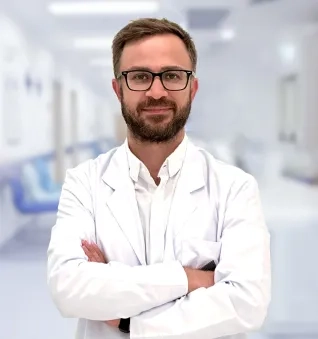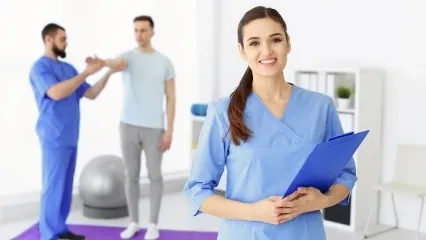Alo Yeditepe
Alo Yeditepe
What is Scoliosis? Exercise Methods in Scoliosis Treatment
Emphasising that early diagnosis is critical to stop the progression of scoliosis and provide a more successful treatment process, Physical Therapy and Rehabilitation Specialist Assoc. Dr. Gökşen Gökşenoğlu said, ‘When we detect scoliosis at an early stage, we can stop the progression of the curvature in the spine with appropriate exercise therapy and even return it to normal limits. She stated that if the patient is not given an appropriate exercise programme, the opposite may occur..
What is Scoliosis?
Scoliosis is a common problem especially in adolescence. Yeditepe University Hospitals Physical Therapy and Rehabilitation Specialist reminded that the incidence of idiopathic scoliosis, i.e. scoliosis of unknown cause, in adolescents between 10-18 is approximately 2-4 per cent and said, ‘While the rate of scoliosis of 10 degrees and above is 2-4 per cent, the incidence of scoliosis of 20 degrees and above is around 0.3-0.5 per cent.’ Reminding that the risk of scoliosis progression in girls is 8-10 times higher than boys, Assoc. Prof. Dr. Gökşenoğlu pointed out the importance of regular screening, especially during adolescence.
What Causes Scoliosis?
According to the recently published literature researches, a large part of scoliosis, around 80 per cent, is of the idiopathic type, the cause of which has not yet been determined, and that it occurs mostly during adolescence, when height growth is rapid, our specialist said, ‘Since the development of children is very rapid during this period, there are studies that have determined that scoliosis can grow at the same rate. Therefore, we can say that early intervention is the sine qua non of scoliosis treatment.’ He said.
How to recognise scoliosis?
Our specialist reminded that early diagnosis of scoliosis can yield promising results and that parents should be very careful at this point and concluded his words as follows: ‘If families often come across their children sitting crookedly, if they think that their clothes look disproportionate, or if they notice that their hunchback is increasing and their shoulders are asymmetrical, I recommend that they consult the relevant physicians without wasting time..”
Does exercise improve scoliosis?
Pointing out that there are many scientific studies supporting the effectiveness of exercise in the treatment of scoliosis, our expert shared the following information: ‘Loss of flexibility is common in spinal curvatures. Hawes has conducted studies emphasising the importance of maintaining and increasing flexibility. Exercises help to stop the progression of scoliosis, reduce its curvature, improve cosmetic appearance and reduce the negative effects of the corset, if used. In adults, scoliosis-specific exercises give successful results in the treatment of pain.”
Which Exercise Programme is Applied to a Scoliosis Patient?
My expert explained how exercise programmes should be for children diagnosed with scoliosis with the following sentences: ‘In children diagnosed with scoliosis, the physician determines the treatment programme and targets. He works together with an experienced physiotherapist. The most important point here is that scoliosis treatment is personalised and each exercise should be given individually. The same exercise programme may not be applied in every scoliosis patient.”
Scoliosis Degree Can Be Reduced Even Before Surgery With Correct Exercise
Pointing out that the success rate of surgery can also be increased with the right exercise programme, our specialist said, ‘Since we have cases where the degree of scoliosis decreases when exercise is performed before surgical intervention, we can increase the success rate of surgery. In some cases, we can get positive results with exercise without the need for surgery.’ He said.
Stating that for more than 100 years, special exercises have been applied in the treatment of scoliosis, our expert listed the following approaches: ‘Schroth, Schroth Best Practice, Lyon, Scientific Exercise Approach for Scoliosis, Barcelona Scoliosis Physical Therapy School, Dobomed, Side Shift and Functional Individual Treatment of Scoliosis. ‘The most widely used and proven method is the Schroth method. Recent research shows that Schroth Best Practice exercises are one of the most effective methods.”
Parents' Attitude is Important
Drawing attention to the role of parents in the treatment of scoliosis, Yeditepe University Physical Therapy and Rehabitation Specialist continued his words as follows ‘Families can sometimes pressure their children to exercise or tell them to stand upright because they are afraid of progression or in order to follow them closely. However, this approach can be tiring for children. Children should exercise with dedication and organise their daily lives in this way, knowing that scoliosis can be corrected without fear of scoliosis. Together with our physical medicine and rehabilitation team, we attach importance to family education. We aim to make children enjoy exercise and make it a part of their lives rather than forcing them to exercise..”
This content was prepared by Yeditepe University Hospitals Medical Editorial Board.
”
See Also
- What is Neurological Rehabilitation?
- Benefits of Being Limber
- Benefits of Physiotherapy and Rehabilitation in Spinal Cord Injury
- Fibromyalgia in Children
- Spinal Cord Injuries and Symptoms
- Beware of Joint and Muscle Pain in the Winter Months!
- Lumbar Disc Herniation (Herniated Disc)
- Sports Injuries
- What is Lymphedema?
- The Way to Peace: Yoga
Alo Yeditepe



